Photo

The Wizzard and his Fox .... you will note the Wizzard has put Jeep’s chicken on the deck and is waiting for his friend to come and join him. Luring a courser. Look at him hoping his bribe works!
the Wizzard, Borzoi
#the Wizzard#Borzoi#sighthound#luring#out on deck#photozoi#5-2023#original photo#favourite toys#hummingbird garden
28 notes
·
View notes
Text

Hummingbird tray.
#cindylacollaart#artlicensing#illustration#hummingbird#hummingbird garden#flowers#floral#art licensing#surface pattern design#hummingbird design
1 note
·
View note
Text
A sphinx moth enjoying moonflowers in the garden.
Cochise County, Arizona, September 2023.
#insect#moth#sphinx moth#flower#photographers on tumblr#textless#amadee ricketts#game camera#video#night#black and white#datura#moonflower#in the yard#garden#fall#autumn#proboscis#gardening at night#hummingbird moth#white lined sphinx moth#arizona
10K notes
·
View notes
Text

Rufous
#photography#garden#nature#wildlife#bird#animal#hummingbird#birds#cute#love#adorable#original art#artists on tumblr
2K notes
·
View notes
Text
Things to Do that Aren't Related to Growing Plants
This is my second post in a series I’ll be making on how to increase biodiversity on a budget! I’m not an expert--just an enthusiast--but I hope something you find here helps!
Some of us just don’t have much luck when it comes to growing plants. Some of us simply want to aim for other ways to help that don’t involve putting on gardening gloves. Maybe you've already got a garden, but you want to do more. No problem! There’s a couple of options you can look into that’ll help attract wildlife in your area without even having to bring out any shovels!
Provide a Water Source
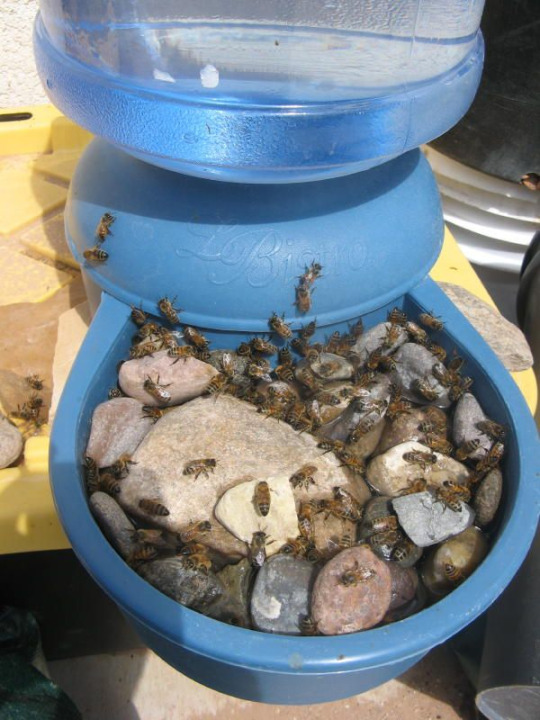
Oftentimes when I see ‘add a water source’ in informational articles about improving your backyard for wildlife, it’s almost always followed by an image of a gorgeous backyard pond with a waterfall and rock lining that looks expensive to set up, difficult to maintain, and overall just… not feasible for me. Arguably, not feasible for a lot of people. And that’s okay! There’s still ways to add water in your garden for all kinds of creatures to enjoy!
There’s tons of ways to create watering stations for insects like bees and butterflies. A self refilling dog bowl can work wonders! Add some stones into the receiving tray for insects to land on or use to climb out, and you’ve got a wonderful drinking spot for all kinds of insects! You can also fill a saucer or other dish with small stones and fill it, though it’ll likely need refilling daily or even several times a day during hot times.
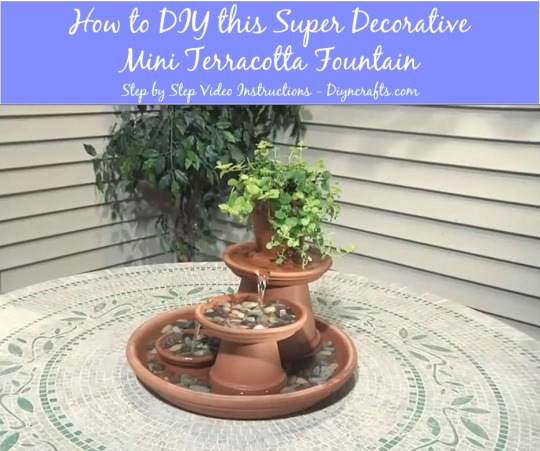
I've seen people online use all kinds of things to make water features. Some go with terra-cotta pots, pebbles, and a cheap pump to get a small and simple fountain. Others use old tires, clay, and a hole in the ground to create an in-ground mini pond system. If all else fails, even a bucket or watertight box with a few plants in it can do the trick--though do be wary of mosquitoes if the water isn’t moving. In situations like these, a solar-powered fountain pump or bubbler are great for keeping the water moving while still making it a drinking option for wildlife (it not even more appealing for some)--and these items can be obtained fairly cheap online!
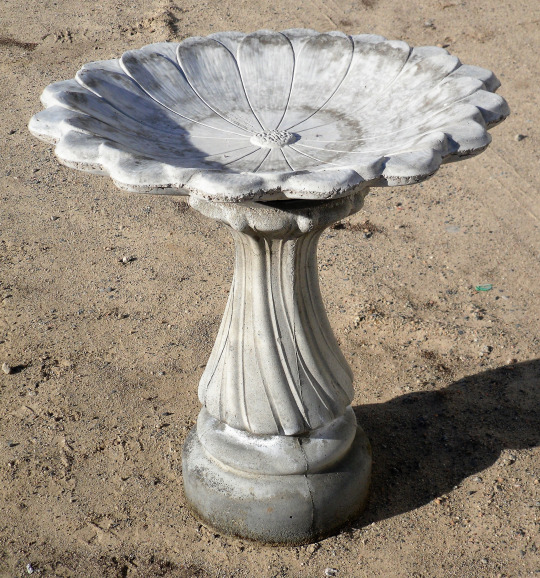
Bird baths are an option as well--a classic way to provide for birds in your area, they can be easy to find online or in a gardening store! The only downside is that a good, quality bird bath can be pricey up-front. However, a nice stone bird bath should last a long time, be easy to clean and refill, and be enjoyed by many birds! I’ve also seen tutorials on how to make your own with quickcrete! Bird baths will be a welcome sight to birds, as they provide a space for them to drink and bathe to regulate the oils in their feathers for flight and insulation. Putting a stone in the middle will also help insects to escape if they fall in, and provide a place to perch so they can get their own drink. You’ll want to change the water and clean the baths regularly--as often as once a week, if you can manage it.
If possible, it’s highly encouraged to fill and refill water features with rainwater instead of tap water. Tap water is often treated, so instead of using hoses or indoor kitchen water, collecting some rainwater is a great alternative. Collecting rainwater can be as simple as leaving cups, bins, or pots outside for awhile.
Butterflies and other creatures will also drink from mud puddles. If you can maintain an area of damp soil mixed with a small amount of salt or wood ash, this can be fantastic for them! Some plants also excel at storing water within their leaves and flowers (bromeliads come to mind), making them an excellent habitat for amphibians as well as a drinking spot for insects and birds.
Bird Feeders and Bird Houses

Some of the fancy, decorated bird feeders are expensive, but others can be pretty low-cost--I got my bird feeder from Lowe’s for around 10 dollars, and a big bag of birdseed was around another 10 dollars and has lasted several refills! If you don’t mind occasionally buying more birdseed, a single birdfeeder can do a lot to attract and support local birds! If you’re handy, have some spare wood, and have or can borrow some tools, you may even be able to find instructions online to make your own feeder. You may not even need wood to do so! Even hummingbird feeders, I’ve found, are quick to attract them, as long as you keep them stocked up on fresh sugar water in the spring and summer!
An important note with bird feeders is that you have to make sure you can clean them regularly. Otherwise, they may become a vector for disease, and we want to avoid causing harm whenever possible. Also keep an ear out and track if there’s known outbreaks of bird diseases in your area. If local birding societies and scientists are advising you take your birdfeeders down for awhile, by all means, do it!
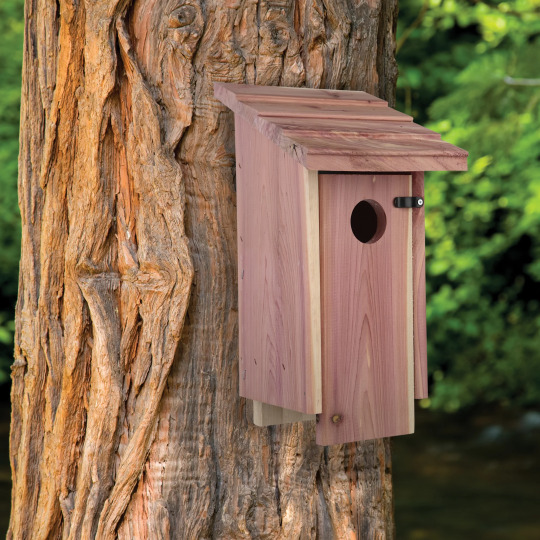
Bird houses are naturally paired with bird feeders as biodiversity promoters for backyard spaces, and it makes sense. Having bird houses suited to birds in your area promotes them to breed, raise their young, disperse seeds, and generally engage in your surrounding environment. Setting them up takes careful selection or construction, preparation, and some patience, but sooner or later you might get some little homemakers! Keep in mind, you will need to clean your birdhouses at least once a year (if not once per brood) to make sure they’re ready and safe for birds year after year--you wouldn’t want to promote disease and parasites, after all. But they could be a valuable option for your landscape, whether you purchase one or construct your own!
Again, do make sure you're putting up the right kind of boxes for the right kinds of birds. Bluebird boxes are some I see sold most commonly, but in my area I believe they're not even all that common--a nesting box for cardinals or chickadees would be far more likely to see success here! And some birds don't even nest in boxes--robins and some other birds are more likely to use a nesting shelf, instead! Research what birds live in your area, take note of any you see around already, and pick a few target species to make homes for!
Solitary Bee Houses
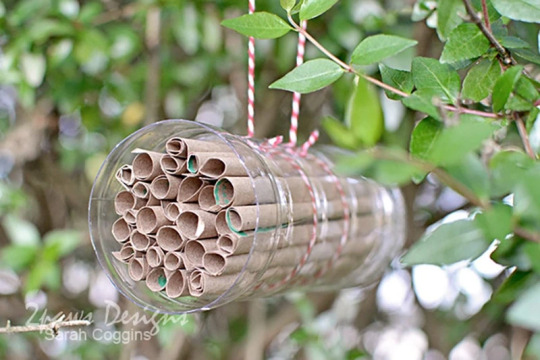
A bee house or bee hotel is a fantastic way to support the solitary bees in your area! For a few dollars and some annual cleaning, you can buy a solitary bee house from most big box nurseries. Alternatively, you can make one at home, with an array of materials you may already have lying around! You can even make them so that they’ll benefit all kinds of insects, and not necessarily just bees.
Though you don’t even necessarily have to break out the hammer and nails, buy a ton of bricks, or borrow a staple gun. Making homes for tunneling bees can be as simple as drilling holes in a log and erecting it, or drilling holes in stumps and dead trees on your property. You might even attract some woodpeckers by doing this!
Providing Nesting Area
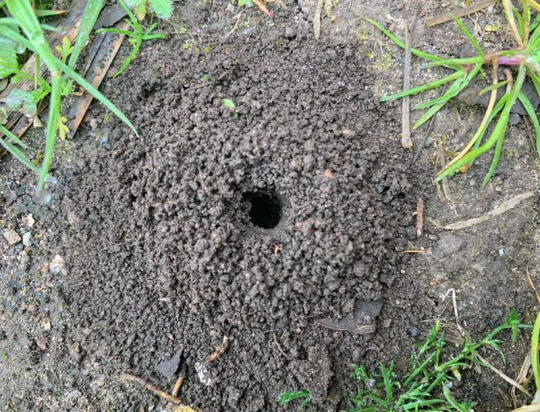
There are tons of different kinds of bees, and they all make different kinds of homes for themselves. Not all of them make big cavity hives like honey bees, or will utilize a solitary bee house. Bumblebees live in social hives underground, particularly in abandoned holes made by rodents--some others nest in abandoned bird nests, or cavities like hollow logs, spaces between rocks, compost piles, or unoccupied birdhouses. Borer, Ground, and Miner bees dig into bare, dry soil to create their nests. Sparsely-vegetated patches of soil in well-drained areas are great places to find them making their nests, so providing a similar habitat somewhere in the garden can encourage them to come! I do talk later in this document about mulching bare soil in a garden--however, leaving soil in sunny areas and south-facing slopes bare provides optimal ground nesting habitat. Some species prefer to nest at the base of plants, or loose sandy soil, or smooth-packed and flat bare ground. They’ve also been known to take advantage of soil piles, knocked over tree roots, wheel ruts in farm roads, baseball diamonds and golf course sand traps. You can create nesting ground by digging ditches or creating nesting mounds in well-drained, open, sunny areas with sandy or silty soil. However, artificially constructed ground nests may only have limited success.
Providing Alternative Pollinator Foods
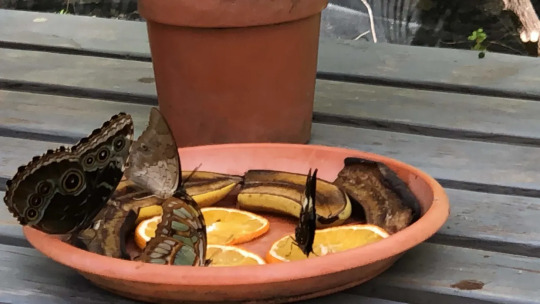
Nectar and pollen aren’t the only foods sought out by some pollinators! Some species of butterflies are known to flock to overripe fruit or honey water, so setting these out can be an excellent way to provide food to wildlife. You may want to be cautious about how you set these out, otherwise it can help other wildlife, like ants or raccoons. Butterflies may also drop by to visit a sponge in a dish of lightly salted water.
Bat Houses and Boxes
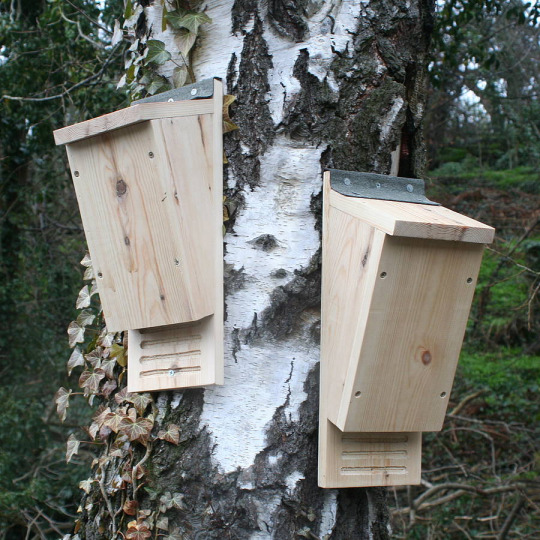
Big or small, whether they support five bats or five hundred, making bat boxes and supporting local bats is a great way to boost biodiversity! Not only will they eat mosquitoes and other pest species, but you may also be able to use the guano (bat droppings) as fertilizer! Do be careful if you choose to do that though--I’ve never had the opportunity to, so do some research into how strong it is and use it accordingly.
Provide Passageway Points
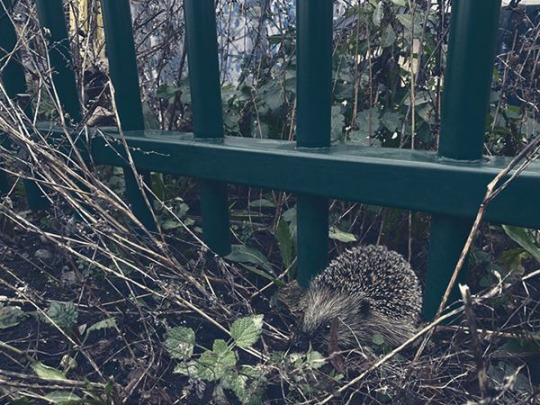
If you want your area to be more accessible for creatures that can’t fly or climb fences, allowing or creating access points can be an excellent way to give them a way in and out. Holes in the bottom of walls or fences can be sheltered with plants to allow animals through.
In a somewhat similar manner, if you’re adding a water fixture, it’s important to provide animals a way to get into and out of the pond--no way in, and they can’t use the water. No way out, and they may drown. Creating a naturalistic ramp out of wood beams or sticks, or stepped platforms out of bricks, stones, or logs can do the trick.
Get or Keep Logs and Brush Piles

I’ve already mentioned logs a good handful of times so far in this post. To be used as access ramps, or as nesting areas for solitary bees. But they have value as much more than that! Logs on the ground provide shelter for all kinds of animals, especially depending on size--anything from mice, reptiles, and amphibians to things like turkey vultures and bears will use fallen logs as shelter. Inside of a decaying log, there’s a lot of humidity, so amphibians are big fans of them--meanwhile, the upper sides of them can be used as sunning platforms by things like lizards. Other animals can also use the insides of logs as nest sites and hiding places from predators too big to fit inside. Fungi, spiders, beetles, termites, ants, grubs, worms, snails, slugs, and likely much more can be found inside rotting logs, using the rotting wood as food sources or nesting places. They can then provide food for mammals, amphibians, reptiles, and birds. They can also be regarded as a landmark or territory marker as wildlife get more familiar with your space.
So how do you get logs for cheap? Try Chip Drop! I talk about them more in a future post, but you can mark saying that you’d like logs in your drop, so they’ll give you any they have! In fact, you may even get a drop faster if you're willing to accept some logs. You may also be able to approach arborists you see working in your area and ask for logs. There may also be local online listings for people selling logs for cheap, or just trying to get rid of them. If there’s land development going on near you, you may be able to snag logs from trees they cut down to make space. Do keep in mind, you don’t need to have huge gigantic logs laying around your property to make an impact--even small logs can help a lot.
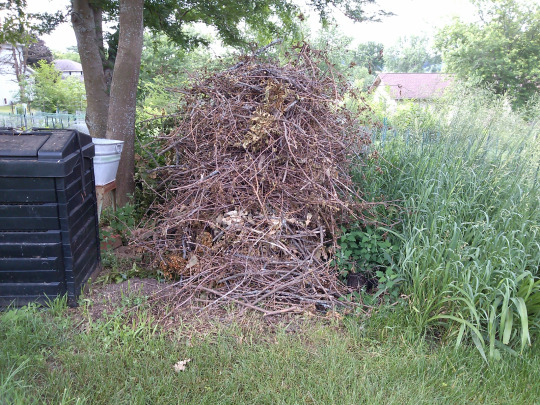
If possible, creating and leaving brush piles on the edge of your property can be a great boost to biodiversity--even if you may not see the wildlife using it. They’ll provide shelter from weather and predators, and lower portions are cool and shady for creatures to avoid the hot sun. The upper layers can be used as perch sites and nest sites for song birds, while lower layers are resting sites for amphibians and reptiles, and escape sites for many mammals. As the material decays, they also attract insects, and as such they’ll attract insect-eating animals too. As more small animals find refuse in your brush pile, their predators will be attracted to them as well. Owls, hawks, foxes, and coyotes are known to visit brush piles to hunt. Making a brush pile can be as simple as piling branches and leaves into a mound, as big or as small as you want. You can even use tree stumps or old fence posts near the base, and keep stacking on plant trimmings and fallen branches. Do note that you don’t want to do this near anything like a fire pit.
Don't forget, with all of these, your mileage may vary for any variation of reasons, so don't worry if you can't take all of even any of these actions! Even just talking about them with other people may inspire someone else to put out a bat box, or leave a few logs out for wildlife!
That's the end of this post! My next post is gonna be about ways to get seeds and plants as cheaply as possible. For now, I hope this advice helps! Feel free to reply with any questions, success stories, or anything you think I may have forgotten to add in!
#biodiversity#solarpunk#environmental stewardship#gardening#outdoor gardening#(i know this is literally the Dont Gotta Garden post but these could also be excellent additions to a preexisting garden so)#ani rambles#out of queue#the biodiversity saga#here in the tags to once again emphasize your mileage may vary with all of these#my mom is scared of bats theres no way in hell shes gonna let me put up a bat box#but I have been able to put out a shallow bird bath and a little solarpowered hummingbird bath fountain#do what you can! every bit counts! You may be able to do something that I or your neighbors can't!#for example my nextdoor neighbors have literally no trees in their backyard where the hell would they put a bat box#meanwhile i have trees in my backyard but still can't put up a bat box. maybe the neighbors next to me could!#similarly brush piles are a no go for my family but someone somewhere else could set one up!#i am rambling in the tags now uh long story short do what you can don't stress about what you can't
4K notes
·
View notes
Text

#HUMMINGBIRD HAWK MOTH👐🏻& CATNIP👾🍃
@samirafee
#source: samirafee#own picture#own video#photographers on tumblr#nature#my garden#plants#catnip#butterfly#macroglossum stellatarum#hummingbird hawk moth#may 2024
61 notes
·
View notes
Text
Hummingbird at my flowers
48 notes
·
View notes
Video
Female Anna's Hummingbird!! by Debbie Meader Via Flickr: A female Anna's Hummingbird is on high alert as a Rufous Hummingbird just flew into our backyard. Photo taken in Camas, Washington.
#BIF#Bird#Birds#Birds and Blooms#Birds in Flight#Flickr Nature#Flickr Wildlife#Flowers#Garden#Hummingbirds#Hummingbirds in Flight#Mother Nature#Mother Nature's Beauty#Nature#Nikkor#Nikkor 600mm f/6.3 Prime Lens#Nikon#NikonZ9#Salvia#Female Anna's Hummingbird#Purple#Amistad Salvia#Backyard Birding#Backyard Garden#Camas#Washington#flickr
31 notes
·
View notes
Text

I went out to do something and I guess someone felt I was too close to the hummingbird feeder.
(The trees on the left are the neighbor’s.)
231 notes
·
View notes
Text
Das Taubenschwänzchen – wissenschaftlich Macroglossum stellatarum – gehört zu den Schwärmern, einer Gruppe eigentlich nachtaktiver Schmetterlinge. Das Taubenschwänzchen erscheint tatsächlich wie ein Kolibri, weil es sehr schnell und wendig fliegt. Vor jeder Blüte bleibt es kurz im leicht brummenden Schwirrflug stehen und wechselt dann zur nächsten Blüte. So kann das Taubenschwänzchen in fünf Minuten mehr als hundert Blüten besuchen.

Vogelähnlich ist auch die Gestalt, insbesondere der breite, schwarz-weiß gezeichnete Hinterleib, der einem Federschwanz ähnelt. Die scheinbaren Federn sind jedoch verlängerte Schuppen, mit deren Hilfe Taubenschwänzchen beim Schweben vor den Blüten ausgezeichnet steuern können. Verwechseln kann man das Taubenschwänzchen bei genauem Hinsehen kaum.
#Taubenschwänzchen#Macroglossum stellatarum#Hummingbird hawk-moth#Nature#Garden#July 2023#Wild Life Germany
39 notes
·
View notes
Photo


Hummingbird Garden expansion.
#out on deck#finally moved some plants#Hummingbird Garden#photozoi#6-1-23#original photos#flowers#container gardening
39 notes
·
View notes
Text
Hummingbird moth 🙌🩷
#hummingbird moth#insect video#insect#insects#garden vibes#garden friends#my garden#buddleja#nature#nature aesthetic#nature video#nature vibes#nature view#garden aesthetic#my video#my videos#my blog#insectblr
24 notes
·
View notes
Text




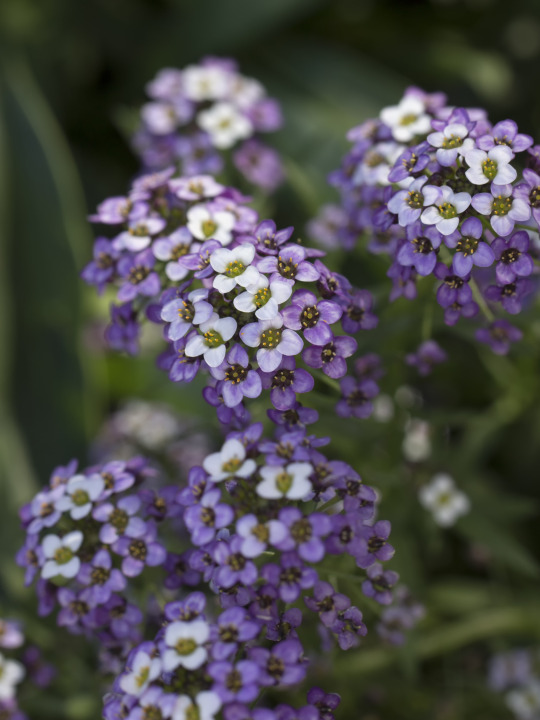
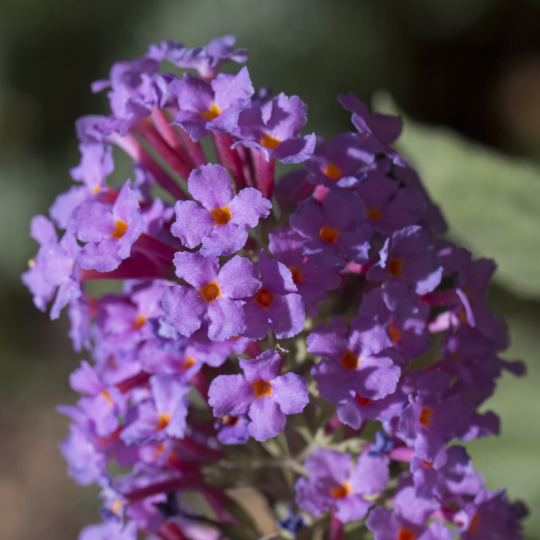
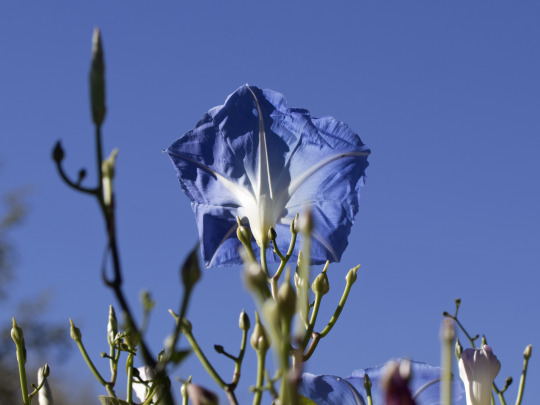
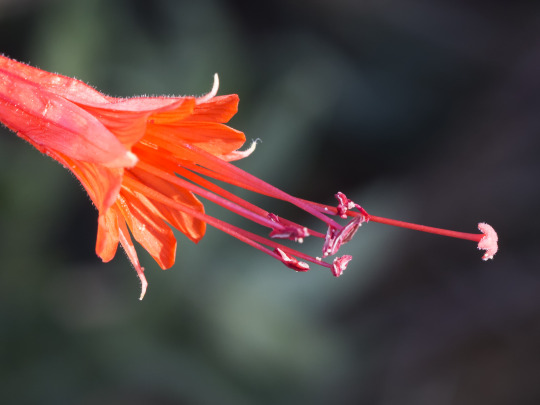


Garden flowers. Cochise County, Arizona, fall 2023.
#flower#cosmos#pink#morning glory#photographers on tumblr#textless#amadee ricketts#arizona#macro#sky#blue#heavenly blue#red#hummingbird trumpet#alyssum#snapdragon#mexican sage#garden#in the yard#purple#orange#fall#autumn#september#october#november
219 notes
·
View notes
Text


Anna's hummingbird
#photography#garden#nature#wildlife#bird#animal#hummingbird#birds#original art#cute#love#adorable#artists on tumblr
565 notes
·
View notes
Text
Happy bird (by:My Garden of Eve)
So happy to see the hummingbirds are still here. I always love seeing its little tongue. This is one happy little girl talking away while she’s eating. I’ll definitely miss them.

14 notes
·
View notes
Text

#SOME B-FLIES ARE STILL HERE…
🦋🍁🌸
@samirafee
#source: samirafee#own picture#own video#photographers on tumblr#my garden#butterflies#polygonia c-album#comma butterfly#macroglossum stellatarum#hummingbird hawk moth#buddleia#october 2024
21 notes
·
View notes
